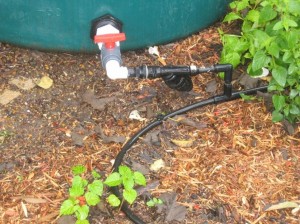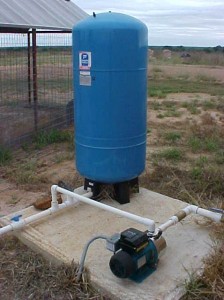 The distribution component of a RWH includes all of the piping, pumps, and other devices that move water from the storage and treatment to the point-of-use. If you are using a RWH system for drip irrigation by gravity flow, the distribution system may simply be a length of drip tubing (left). However, if you plan to use the water indoor under pressure, there will be a few more key components. (*Piping water into a home involves complex water pressure and should be done by a licensed plumber. If you plan to connect the rainwater to a plumbing system where municipal water already exists, you must check with local laws/ordinances to determine what type of backflow prevention devices are necessary.*)
The distribution component of a RWH includes all of the piping, pumps, and other devices that move water from the storage and treatment to the point-of-use. If you are using a RWH system for drip irrigation by gravity flow, the distribution system may simply be a length of drip tubing (left). However, if you plan to use the water indoor under pressure, there will be a few more key components. (*Piping water into a home involves complex water pressure and should be done by a licensed plumber. If you plan to connect the rainwater to a plumbing system where municipal water already exists, you must check with local laws/ordinances to determine what type of backflow prevention devices are necessary.*)
Friction Loss
One issue to keep in mind is a loss in pressure due to friction in the pipes. If you plan on moving water a good distance from your storage, it may be useful to calculate friction loss to make sure the end-use has enough pressure. To do this you need to know the length of pipe, diameter of pipe, fittings included, and flow of water leaving the storage (or pump). Then use the Hazen-Williams friction loss equation to calculation friction loss. The equation is shown below or you can you the Excel Spreadsheet on the Calculators page.
Pumps and Pressure Tanks

 Pumps and Pressures tanks are two important parts to ad distribution system. If you are using gravity flow from a rain barrel or tank, you won’t need to worry about a pump. Pumps for a RWH system come in several types and sizes. Choosing the right one for your situation will depend on the pressure and volume requirements that you need. For example, an indoor shower may only require 30 psi (pressure) and 2.5 gallons per minute (volume). You need to add up the volumes needs for all of your intended uses. The pressure requirement depends on the appliance/irrigation device requirements. Go to a pump supplier pressure and volume requirements to pick the ideal pump for your situation. In addition to the pump, a pressure tank may be useful, especially when the rainwater is used for indoor purposes. Indoor use often involves several small uses throughout the day (i.e. turning on the sink, flushing the toilet, doing dishes). Having water demand several times a day requires the pump to turn off and on repeatedly, which is bad for the pump. The pressure tank keeps a certain amount of water stored under pressure and only forces the pump to turn on periodically to fill the tank back up.
Pumps and Pressures tanks are two important parts to ad distribution system. If you are using gravity flow from a rain barrel or tank, you won’t need to worry about a pump. Pumps for a RWH system come in several types and sizes. Choosing the right one for your situation will depend on the pressure and volume requirements that you need. For example, an indoor shower may only require 30 psi (pressure) and 2.5 gallons per minute (volume). You need to add up the volumes needs for all of your intended uses. The pressure requirement depends on the appliance/irrigation device requirements. Go to a pump supplier pressure and volume requirements to pick the ideal pump for your situation. In addition to the pump, a pressure tank may be useful, especially when the rainwater is used for indoor purposes. Indoor use often involves several small uses throughout the day (i.e. turning on the sink, flushing the toilet, doing dishes). Having water demand several times a day requires the pump to turn off and on repeatedly, which is bad for the pump. The pressure tank keeps a certain amount of water stored under pressure and only forces the pump to turn on periodically to fill the tank back up.